

Backyard Chicken Lady ...thinking out loud: Lacto-Fermentation ~ Making My Own Fermented Chicken Feed. As you've probably guessed by now, I love experimenting with new things.
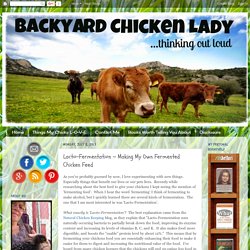
Especially things that benefit our lives or our pets lives. Recently while researching about the best feed to give your chickens I kept seeing the mention of 'fermenting feed'. When I hear the word 'fermenting' I think of fermenting to make alcohol, but I quickly learned there are several kinds of fermentation. The one that I am most interested in was 'Lacto-Fermentation'. What exactly is 'Lacto-Fermentation'? This sounded like an experiment that I definitely wanted to try.
First I needed a container to ferment my feed in. My chickens currently eat dry crumbles so I started with that. I mixed these dry ingredients up in the bowl then covered them with about 1' to 1-1/2" of unchlorinated water above the level of the feed. Fermenting Chicken Feeds the Right Way! Fermenting certain foods is a very traditional method of food preservation and also enhancing nutrition.
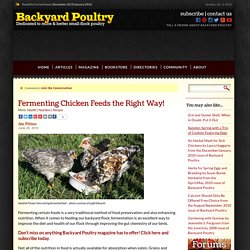
When it comes to feeding our backyard flock, fermentation is an excellent way to improve the diet and health of our flock through improving the gut chemistry of our birds. Don’t miss on anything Backyard Poultry magazine has to offer! Click here and subscribe today. Not all of the nutrition in food is actually available for absorption when eaten. Grains and legumes in particular are designed to “pass-through” the creature consuming them and come out the other side still fully able to sprout, if possible. The anti-nutrients which are typically found in legumes, grains and seeds are: 1) phytic acid; 2) enzyme inhibitors; 3) tannins; and 4) hard-to-digest proteins. Fermentation reduces or fully eliminates the anti-nutrient properties in grains and legumes. There are various types of fermentation. Natural Chicken Keeping: Fermented Feed. What the heck is fermented feed and why on earth would you want to give it to chickens?
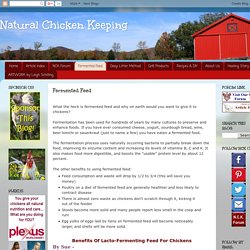
Fermentation has been used for hundreds of years by many cultures to preserve and enhance foods. If you have ever consumed cheese, yogurt, sourdough bread, wine, beer kimchi or sauerkraut (just to name a few) you have eaten a fermented food.The fermentation process uses naturally occurring bacteria to partially break down the food, improving its enzyme content and increasing its levels of vitamins B, C and K. How to Ferment chicken feed.Bigger eggs, healthier chickens. I’m handing the reins, or in this case the coop, over to Leigh Edwards today.

Leigh runs the blog Natural Chicken Keeping. It’s a really, REALLY great chicken keeping website with tons of information. Leigh is one of the many who took my How to Turn your Blog into a Business course. 10 Fermenting Tips To Reduce Chicken Feed Costs. Fermenting is all the rage nowadays, both in people foods (think yogurt, sauerkraut, sourdough bread, buttermilk, kimchi, apple cider vinegar, even beer and wine!)
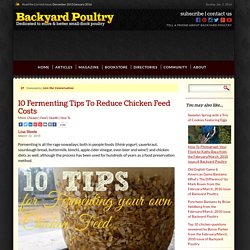
And chicken diets as well, although the process has been used for hundreds of years as a food preservation method. What Is It? Basically fermentation is the process of covering foods in liquid and allowing them to sit, which creates probiotics that assist in digestion and gut health. Studies have shown that feeding fermented feed can increase egg weight, eggshell thickness and boost the chickens’ intestinal health and immune system, increasing their resistance to diseases including Salmonella and E.coli. How to do it Fill your container about 1/3 full with feed. Please watch the short video below on how to start fermenting your feed.
How Does it Save Money? Because the nutrients are more readily absorbed in fermented foods, feed requirements lessen, and there is also less waste since the chickens love it. 1. 2. 3. Why and How to Ferment Your Chicken Feed. I want to share with you a process that’s fascinated me for some time, but I wasn’t ready to share my discovery until I’d had enough experience with it — one year later.
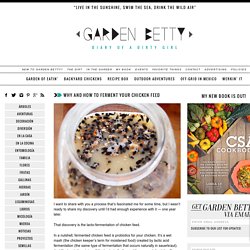
That discovery is the lacto-fermentation of chicken feed. In a nutshell, fermented chicken feed is probiotics for your chicken. It’s a wet mash (the chicken keeper’s term for moistened food) created by lactic acid fermentation (the same type of fermentation that occurs naturally in sauerkraut). Just like kraut, it contains all the bacteria that’s good for your gut: Lactobacillus, Leuconostoc, Pediococcus, and other beneficial bacteria and yeasts. 10 Foods to Ferment for Chickens. Soon after I began fermenting my chickens’ feed, I began experimenting with what I could ferment.

The fermentation process makes nutrients more available, increases digestibility, and promotes beneficial bacteria throughout the digestive tract, so I knew that it wouldn’t hurt to try fermenting foods that I already provided as treats. (Read about the benefits of fermented feed here.) When experimenting with additions to their food, I always kept the proportion the same as what I would feed them normally. For example, a day’s meal of nothing but fermented sunflower seeds would be too high in fiber. Instead, I used at least 85% regular ration, whether layer or grower, and no more than 15% extras. I’ve been fermenting my feed in a deep plastic dish pan, although the plastic is not ideal because it can leach into the feed.